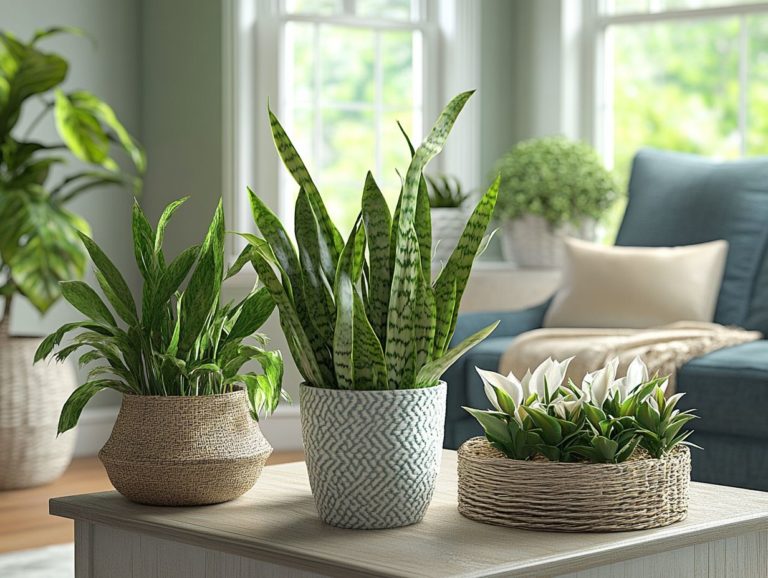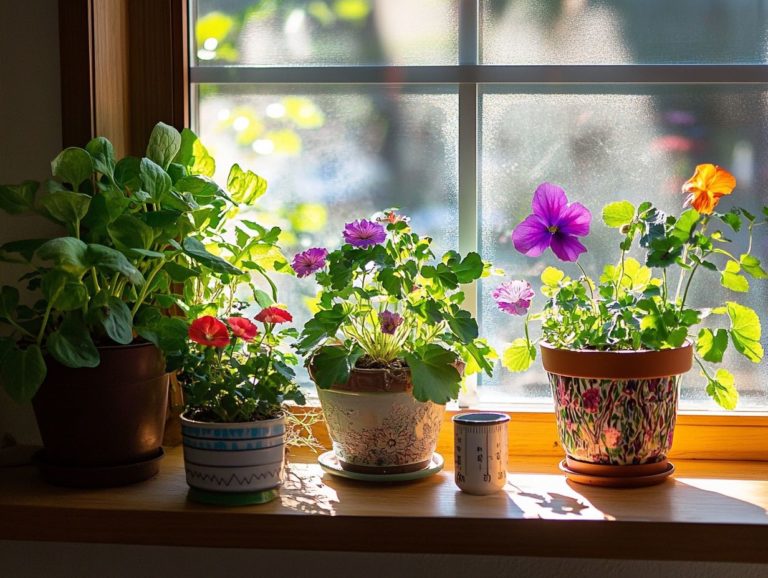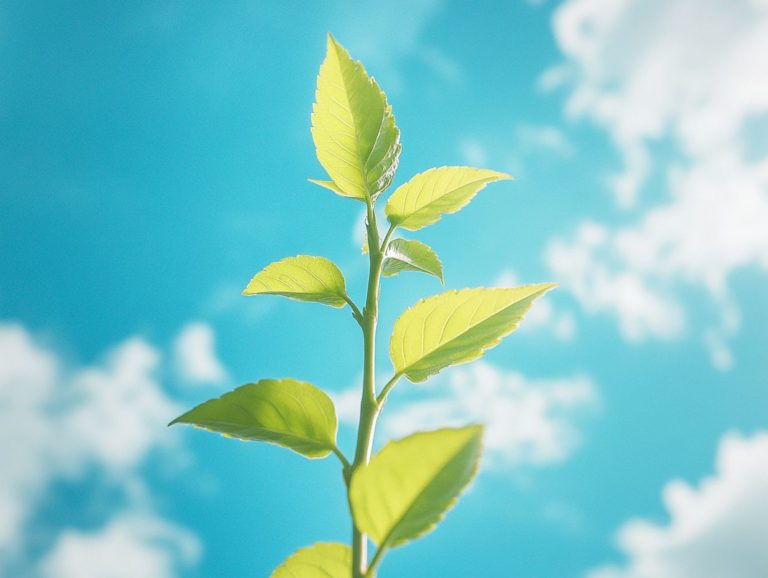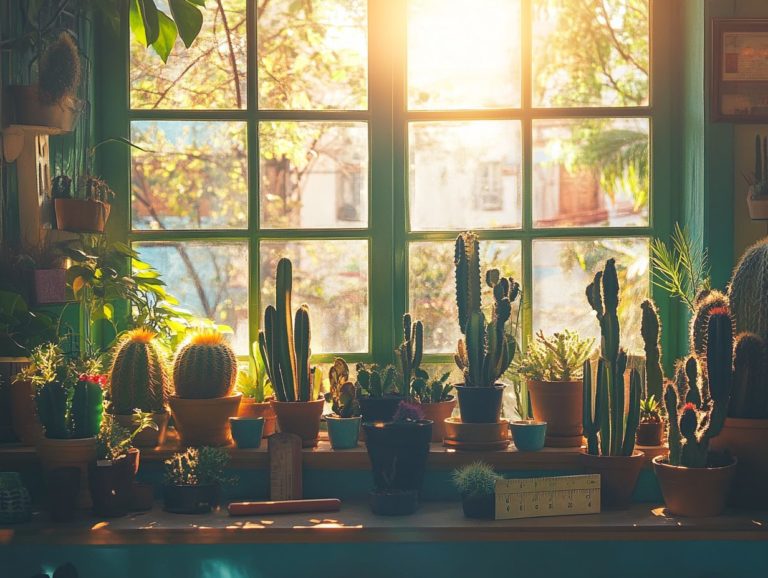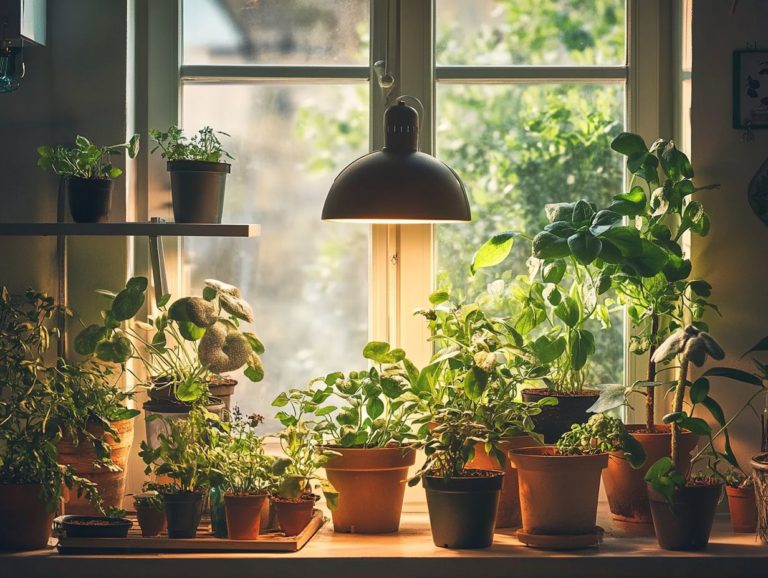How to Create a Light Schedule for Succulents
Succulents have captured the hearts of many as beloved houseplants, celebrated for their distinctive shapes and minimal care requirements. These plants are particularly appreciated for their adaptability and resilience.
These hardy plants thrive under specific lighting conditions. Understanding these light requirements can greatly influence their growth.
Let’s dive into how you can craft an effective lighting schedule that adapts to the shifting seasons, considering factors such as light intensity and light duration.
Gain insights on how to enhance indoor lighting and tackle common challenges like sunburn and inadequate lighting, while ensuring proper light distance and light output.
Transform your space and give your succulents the bright, cheerful home they crave today!
Contents
- Key Takeaways:
- Understanding Succulents and Their Needs
- What are Succulents?
- Light Requirements for Succulents
- Creating a Light Schedule for Succulents
- Adjusting the Light Schedule for Different Seasons
- Enhancing Indoor Light for Succulents
- Troubleshooting Common Light-Related Issues
- Frequently Asked Questions
- 1. How often should I water my succulents?
- 2. How long should I expose my succulents to sunlight?
- 3. Can I use artificial light for my succulents?
- 4. How do I create a light schedule for my succulents?
- 5. Do succulents need darkness to grow?
- 6. Should I rotate my succulents to ensure even light exposure?
Key Takeaways:
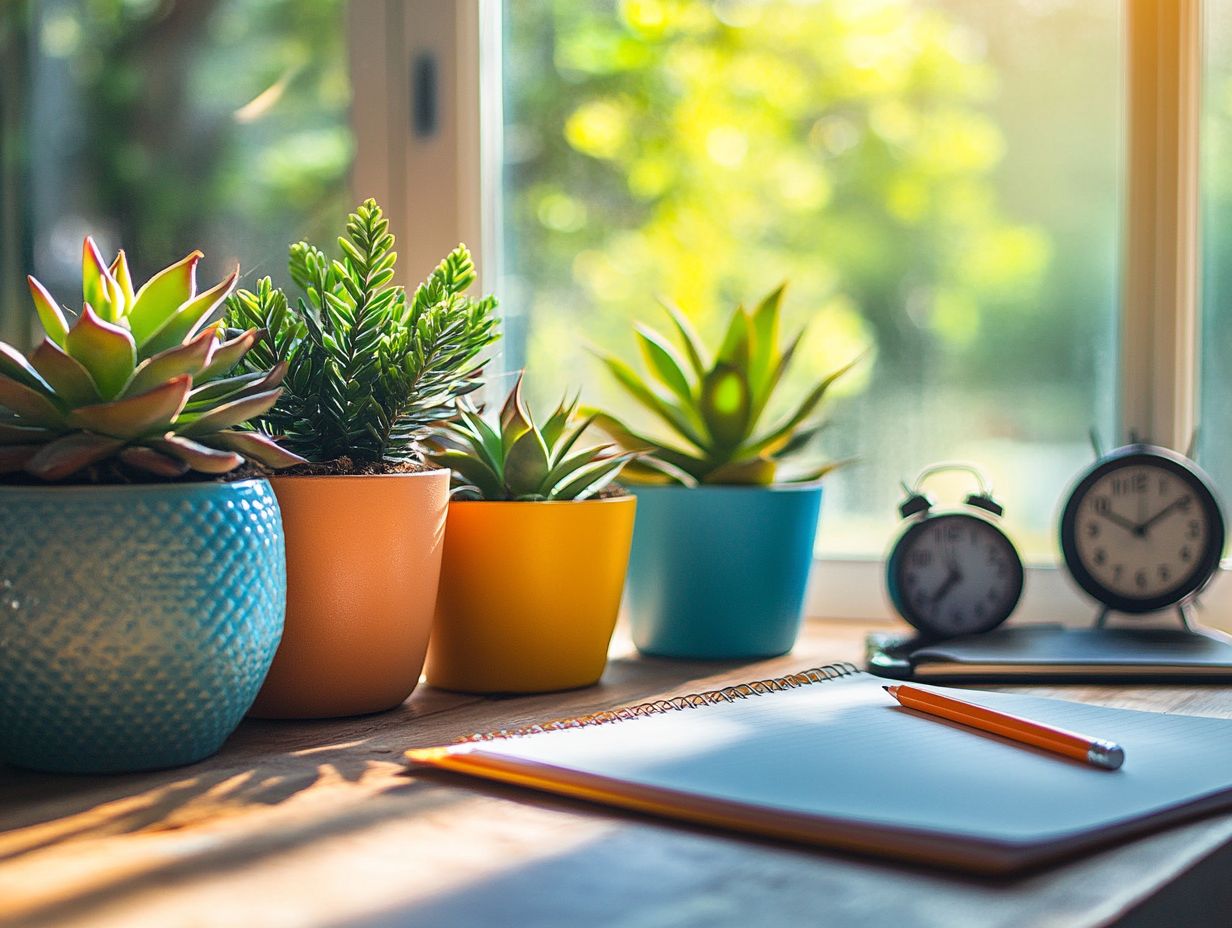
- Understand the specific needs of your succulents, including their light requirements, to ensure their health and growth.
- Consider factors such as natural light availability and seasonality when creating a light schedule for your succulents.
- Incorporate various types of indoor lighting, such as artificial light, to supplement natural light for your indoor succulents.
Understanding Succulents and Their Needs
Understanding succulents and their unique needs is crucial for anyone looking to cultivate healthy and vibrant specimens, including popular varieties like Echeveria, Haworthia, and Sedum plants.
These resilient plants belong to the Crassulaceae family and have evolved to flourish in a variety of environmental conditions. Their remarkable ability to store water in their leaves helps them endure periods of drought. However, the right light conditions and appropriate watering needs play a pivotal role in their overall health and growth.
What are Succulents?
Succulents represent a distinctive group of plants within the Crassulaceae family, renowned for their thick, fleshy leaves that store water. This remarkable adaptation allows them to thrive even in the harshest of arid environments.
Among the many varieties, the beloved Echeveria and the hardy Sedum stand out, demonstrating exceptional adaptability that makes them perfect for gardens focused on sustainable practices. These plants also help conserve water, as they require far less irrigation compared to traditional garden specimens. Their unique ability to retain moisture means they can flourish in dry conditions, making them an excellent choice for anyone seeking to minimize water consumption.
With an array of shapes and colors, succulents create striking visual displays that enhance any landscape, all while demanding minimal maintenance.
Light Requirements for Succulents
The light requirements for succulents are crucial to their health and growth, as they depend on adequate light to facilitate photosynthesis, the process through which plants convert light into energy, allowing them to thrive in both indoor and outdoor settings.
Recognizing that different varieties have their unique light preferences is key. For instance, Echeveria thrives in bright, direct sunlight, while Haworthia may prefer a partially shaded area.
Natural sunlight provides the full spectrum necessary for optimal photosynthesis, resulting in vibrant colors and robust growth. This is particularly influenced by blue light and red light. However, in indoor environments or during winter months, natural light can fall short, making the use of artificial grow lights like LED lights and fluorescent lights essential. These lights should ideally emit a balanced spectrum that mimics sunlight, allowing your succulents to flourish regardless of external conditions.
By fine-tuning your care strategies based on the specific lighting conditions and understanding factors like DLI (Daily Light Integral) and PPFD (Photosynthetic Photon Flux Density), you can significantly elevate the overall well-being and beauty of these resilient plants.
Creating a Light Schedule for Succulents
Establishing a carefully curated light schedule for your succulents is crucial for helping them grow healthy.
This is particularly important for indoor varieties that may not receive enough natural sunlight during the day, especially regarding the warmth of the light and type of light.
By thoughtfully structuring this schedule, you consider both the duration and intensity of light necessary for effective photosynthesis.
This tailored approach enables your succulents to flourish in their unique surroundings while safeguarding them against light deficiency or excess, which may lead to light damage or stunted succulent growth.
Factors to Consider
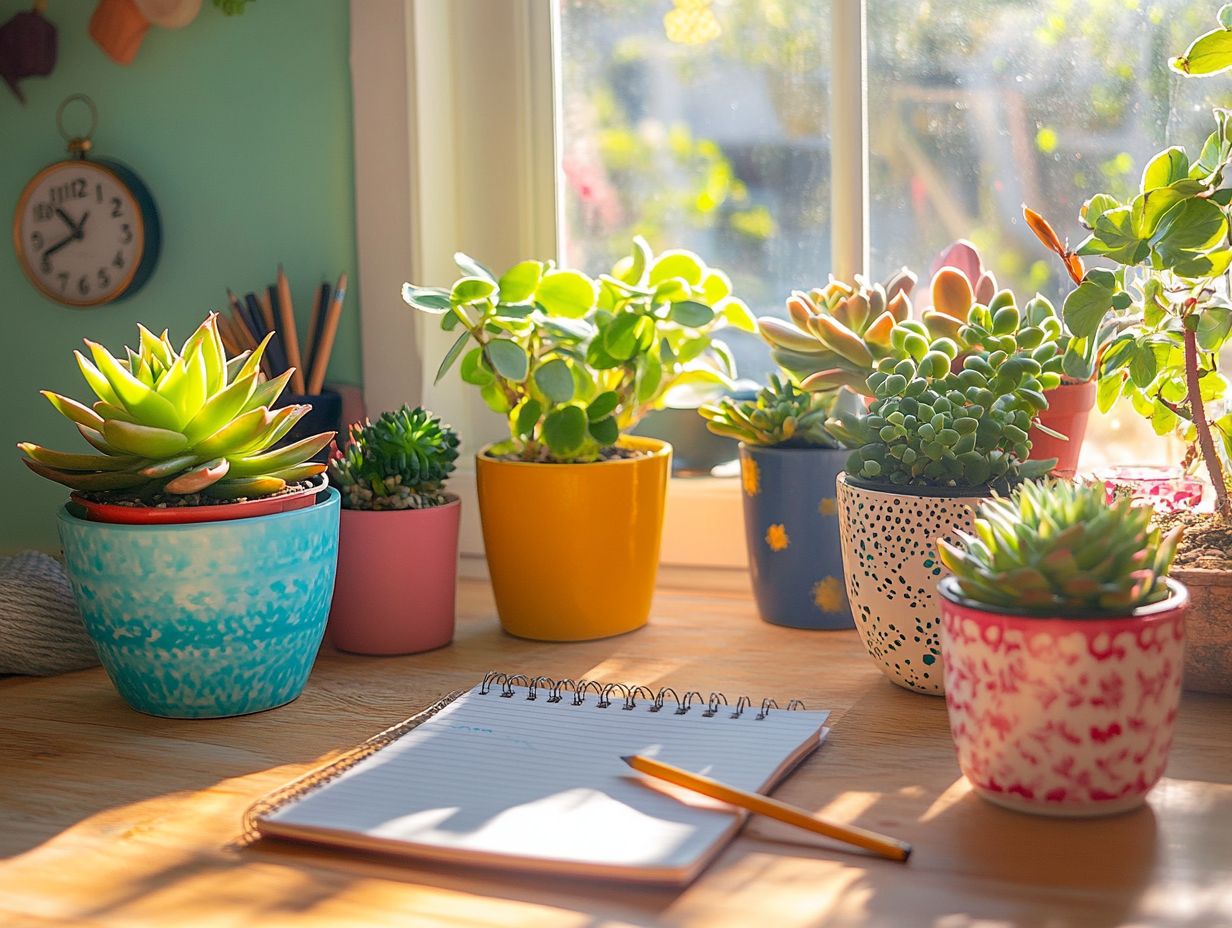
When crafting a lighting schedule for your succulents, you’ll want to consider several key factors: light intensity, light duration, the distance of the light from the plants, and the specific environmental conditions they thrive in, as well as the color temperature of the light used.
Each of these elements is essential for maintaining the health and vitality of these resilient beauties.
For example, light intensity plays a pivotal role in photosynthesis. If your succulents don t get enough light, their growth can stall, while too much exposure can lead to unsightly burns.
The duration of light exposure is equally important; your succulents will flourish under 12 to 16 hours of bright, indirect light each day.
Don’t overlook the distance between the light source and your plants; if the lights are too close, they can generate heat that stresses the foliage.
Finally, understanding the temperature and humidity levels in your environment allows you to tailor the light schedule, giving your succulents the best chance to thrive.
Recommended Light Schedule
A recommended light schedule for your succulents typically involves providing them with 12 to 16 hours of bright, indirect light each day. You can achieve this balance through a mix of natural sunlight and supplemental artificial grow lights.
To truly optimize their growth, it’s essential to grasp their specific needs at different stages. For example, young, actively growing succulents flourish under 14 to 16 hours of light, while mature plants tend to do just fine with about 12 to 14 hours.
Don t overlook the intensity of the light, either. Succulents basking in direct sunlight may need a gradual transition to prevent sunburn.
Utilizing a light meter allows you to assess intensity levels and make necessary adjustments, ensuring that your plants enjoy optimal conditions for photosynthesis.
This complete method ensures that each succulent receives the personalized care it deserves, promoting lush growth and vibrant colors that will leave you in awe.
Adjusting the Light Schedule for Different Seasons
Adjusting the light schedule for your succulents as the seasons change is essential. Seasonal fluctuations can profoundly influence their light requirements, growth rates, and overall health.
In winter, when natural sunlight dwindles, you ll need to adapt your care strategies, possibly increasing the use of artificial grow lights.
Conversely, during the summer months, the longer daylight hours may require you to make adjustments to prevent light damage.
Your attentiveness to these seasonal changes ensures that your succulents thrive year-round.
Winter vs. Summer Light Requirements
The light requirements for your succulents vary greatly between winter and summer. It’s essential to make adjustments that ensure their optimal health and growth throughout the year.
In the summer, these vibrant plants thrive under increased light intensity. They need at least six to eight hours of bright, indirect sunlight to foster robust growth and stunning colors.
As winter rolls in, the sun shifts its position, and daylight hours dwindle. This makes it crucial for you to adapt their lighting conditions.
During winter, your succulents will benefit from about four to six hours of light. You might find that supplemental light sources are necessary to prevent stretching for light.
By understanding these seasonal care practices and adjusting for seasonal fluctuations, you can enhance their winter dormancy and promote remarkable health and vitality in your beloved succulents.
Enhancing Indoor Light for Succulents
Supplementing light is essential for indoor succulents to thrive, especially when natural sunlight is limited.
By employing artificial grow lights like full-spectrum LED lights or fluorescent lights you can significantly improve the light conditions for these hardy plants. This fosters robust growth and vibrant health through optimal light spectrum and light output.
Types of Indoor Lighting
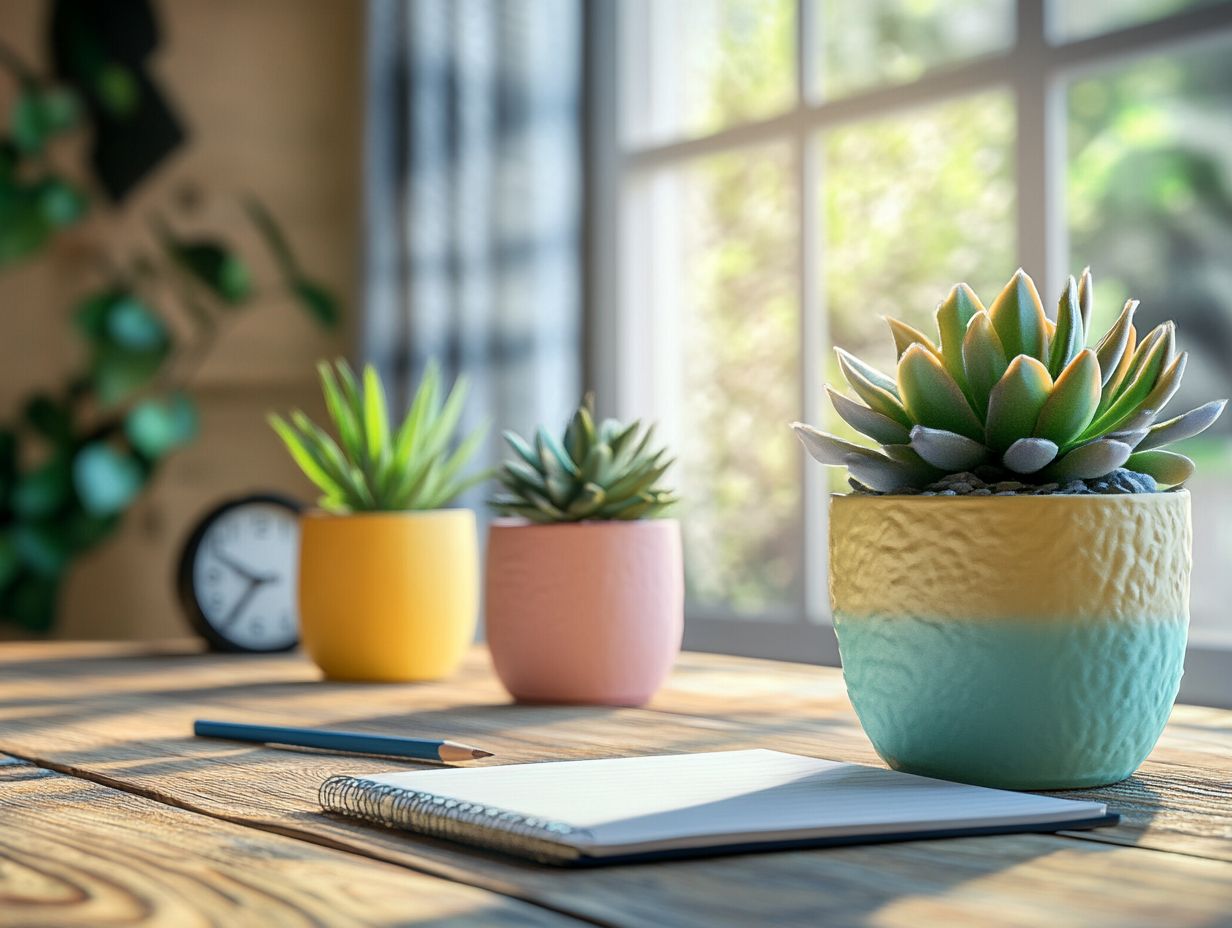
You have several types of indoor lighting at your disposal for nurturing your succulents, including LED lights, fluorescent lights, and high-intensity discharge (HID) options. Each presents its unique benefits and light spectrum characteristics that cater to the specific needs of your plants.
Understanding these options will empower you to create an environment where your plants can truly thrive!
LED lights, for example, are celebrated for their energy efficiency and impressive lifespan. They emit specific wavelengths that encourage robust growth. On the flip side, fluorescent lights offer a gentler glow and are often more budget-friendly, though they may lack the intensity needed for optimal effectiveness.
If you re considering larger setups, high-intensity discharge (HID) lights pack a powerful punch, providing significant output. However, keep in mind they can generate considerable heat and incur higher energy costs.
By weighing these advantages and disadvantages, you can select the best lighting solution tailored to your space and the specific needs of your succulents.
How to Use Artificial Light for Succulents
Using artificial light effectively for your succulents requires a thoughtful approach to placement, distance, and duration to meet their unique growth needs.
For optimal results, position your light source at a distance that mimics natural sunlight, typically between 12 to 24 inches from the plants, depending on how intense the light is.
Keep a close eye on the light levels. While succulents thrive in bright conditions, too much direct light can lead to leggy growth or even scorching. Regularly measuring light intensity with a lux meter (a tool that measures light levels) will ensure your hardy friends receive just the right amount of illumination.
Adjusting the duration of light exposure to around 12 to 16 hours a day can significantly boost their growth and overall health.
Troubleshooting Common Light-Related Issues
Troubleshooting common light-related issues is essential for preserving the health of your succulents and preventing potential damage from insufficient or excessive light exposure.
By recognizing signs of light damage such as discoloration and stretched growth you can make informed adjustments to your light schedules and care strategies, ensuring your plants thrive beautifully.
Identifying and Addressing Sunburn
Identifying and addressing sunburn in your succulents is essential for their long-term health. Excessive light intensity can wreak havoc, resulting in burnt leaves and stunted growth that no one wants to see.
Recognizing these signs early on can help your plants heal. Keep an eye out for symptoms like discoloration particularly yellowing or browning at the leaf tips and crisp, flaky textures that signal prolonged exposure to harsh sunlight.
To help your succulents bounce back, try this: gradually relocate the affected plants to a spot with filtered light, allowing them to acclimate (get used to the new conditions) to more suitable conditions. Tweaking your watering schedule can also alleviate the stress caused by sunburn, helping your plants recover without the added risk of dehydration or further overexposure.
Dealing with Lack of Light
Dealing with insufficient light is a common hurdle for indoor succulent enthusiasts, as inadequate lighting can impede growth and overall health. It’s essential to understand the specific light requirements of these hardy plants.
To ensure your succulents flourish, one effective strategy is to reposition them near natural light sources, such as south or west-facing windows. This way, they’ll soak up the maximum amount of sunlight throughout the day.
If natural light is lacking, use artificial grow lights. These lights will simulate the sunlight your succulents crave, providing the right spectrum and intensity necessary for photosynthesis.
When used correctly, these tools can dramatically enhance the health of your plants and promote lush, vibrant growth, transforming any dimly lit space into a thriving indoor garden.
Frequently Asked Questions
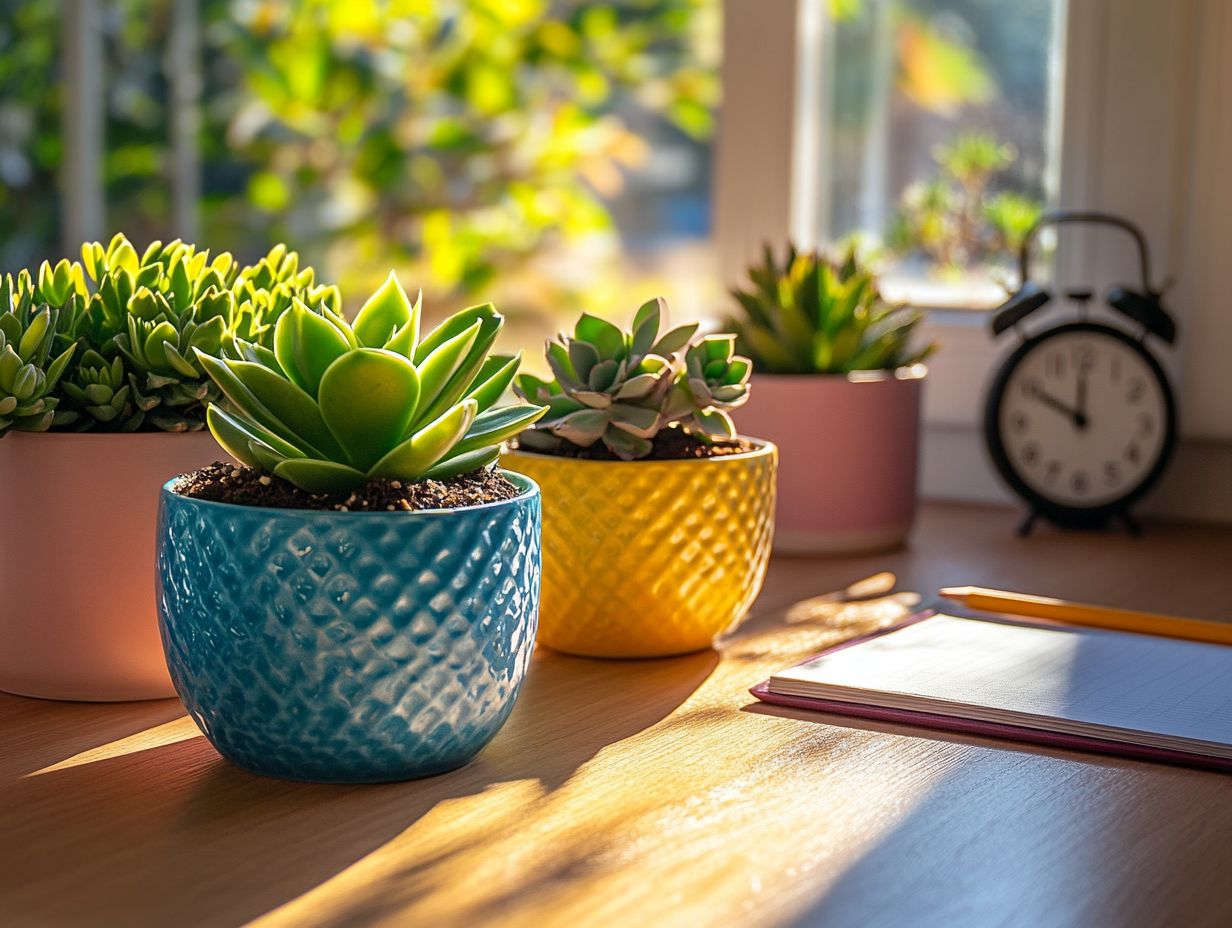
-
1. How often should I water my succulents?
The watering frequency for succulents varies based on the type of plant and its environment. However, a general rule is to water them every 1-2 weeks, allowing the soil to dry out completely in between waterings.
-
2. How long should I expose my succulents to sunlight?
Succulents thrive in bright, indirect sunlight. Depending on the intensity of the light, they should be exposed for 4-6 hours a day. Avoid placing them in direct sunlight as it can cause sunburn and damage to the plant.
-
3. Can I use artificial light for my succulents?
Yes, you can use artificial light for your succulents. LED grow lights or fluorescent bulbs are great options as they provide the necessary wavelengths for plant growth. Keep them on for 8-10 hours a day, and make sure to adjust the distance based on the intensity of the light.
-
4. How do I create a light schedule for my succulents?
Start by determining the type of succulent you have and its light requirements. Then, decide on the source of light and adjust the distance and duration accordingly. It’s crucial to monitor the plant and make changes to the schedule if needed.
-
5. Do succulents need darkness to grow?
Yes, just like any other plant, succulents need a period of darkness to grow. They require at least 6-8 hours of uninterrupted darkness to rest and go through the process of photosynthesis.
-
6. Should I rotate my succulents to ensure even light exposure?
It’s recommended to rotate your succulents once every 2-3 weeks to ensure even light exposure and prevent them from leaning towards one direction. This also helps in promoting even growth and prevents uneven stretching of the plant.
Have any tips or questions about succulent care? Share them in the comments below!

